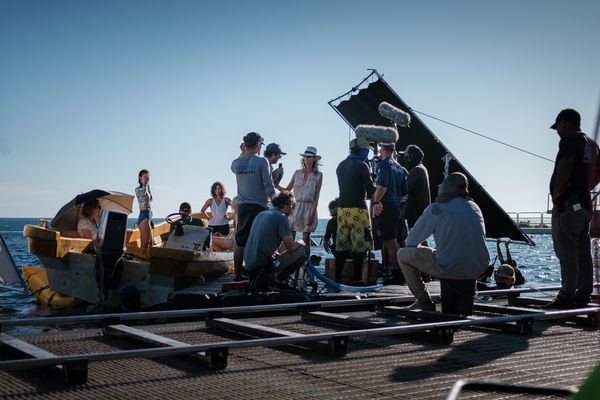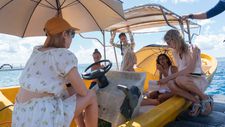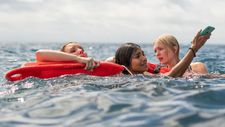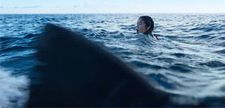 |
| Behind the scenes of Something In The Water |
Although the last few years have seen massive progress for female directors in the industry, there are still relatively few making action films. Hayley Easton Street is bucking the trend. As an art director, she’s worked on big titles like Star Wars: Episode 7 - The Force Awakens, Harry Potter And The Prisoner of Azkaban and Ex Machina, but now she’s pursuing her directorial ambitions. Her shark film Something In The Water reached screens last month and she’s about to commence shooting on heist thriller The Climb. When we connected recently, she told me about how her eclectic career began, how she developed her skills, how Andy Serkis helped her to build up confidence as a director, and what she hopes to do in the future.
“I studied film and photography,” she begins. “I did a foundation at the London College of Printing, and while I was there, I did an extra animation course, which I really loved. I wanted to go on to do a film degree, and I looked at all the film courses available and really, it was very theoretical. There wasn't very much practical. At the time, the visual effects industry in London was booming, so I thought that's what I wanted to do. I went off and I got a job as a runner, and I worked my way up and taught myself how to do visual effects on the night shift.
 |
| Behind the scenes of Something In The Water |
“I got a showreel together and I went and got a job in a commercial place in Covent Garden. It was really great there because when you do small commercials, it's very creative. When you're doing 3D animation and that sort of thing, if you have a very little commercial, you might get to model everything. You animate it, you light it, you do the camera work, you do the whole thing. So it's like making a little film, which is really great. But then as I got better at doing visual effects stuff, I went into film visual effects, and you have to be very specialised, so it becomes more technical. That frustrated me quite a lot.
“I thought ‘Oh, you know what? I'm going to go and design sets. That would be more creative.’ So I got a job working for nothing on a short film and did stand-by art directing, and I kind of worked my way up doing that. Then I took this job doing some previews on a film, and I suddenly realised there was no one in the art department who understood visual effects, and no one in visual effects could read a drawing or anything. We needed a visual effects art director. And so I sort of made up this job in this country, at least in the way I did it. I pitched myself and I got a job doing it on a Roland Emmerich film.
“There's a few visual effects art directors around now. Before me, they were a bit more traditional and they'd be in charge of actually painting backdrops and stuff, but I was going in saying ‘Right, we're going to do it all in 3D, and I'm going to plan the sets and the visual effects, the set extension, the world beyond the set. I'll work out how we're going to shoot it, where we put the green screen, what lens we should have on the camera and what we can see.’ And then I'd take what I'd done and I'd pick a moment in the film with the director and I'd paint it up and light it and make a beautiful piece of concept art. And then we'd use that for visual effects for the art department, and we’d have it on set so that everyone knew what we should shoot and how it should look.
“I'd been writing all along, writing scripts, and I was thinking ‘I feel like I should be making my own film.’ So I went and made a short film [Stealth], and I did some really low budget, 500 quid kind of music videos. Then I wrote a feature screenplay and I sold it. I had this idea for The Climb, and I was talking to various people about it, and this UK production company said that they wanted to make it, and they said ‘We'll commission you to write the script.’ I said ‘Well, the only way I'm going to let you have this is if I direct it. I must make this film myself.’ So I've been developing that for a few years, but then while I was developing it, Something In The Water came along. That was already written. It was already set up at Studio Canal, and they needed a director. I really went for it.
“I did 46 pages of artwork and storyboards and really visualised the whole thing, and I pitched to various people at Studio Canal, and I got the job, which was brilliant. So I made Something In The Water, and then I was still developing The Climb, but amazingly, we've started prep on it now, so we're shooting from November.”
These two films have something in common, I note, in that they're both about groups of women in situations where we don't usually see women behaving realistically onscreen. The trappings of performative femininity are gone and they’re allowed to be themselves and just act like human beings.
 |
| Behind the scenes of Something In The Water |
She nods. “It's really important in Something In The Water. The writer was female, we had a female producer, obviously I was directing it. We had a lot of female heads of department. And, you know, in my previous career, I'd never even worked with a female director, so this felt brilliant. But it was really, you know, like – putting them in bikinis, we’re not having that. This isn't that film. A lot of shark films, I feel, play on that, and have a lot of women flailing around in bikinis. These are independent, strong women, and we can see them fighting for their lives. And The Climb, again, it's about these six strong women who are doing this thing for themselves. It feels brilliant to be able to direct those sort of stories.
“I think it was really important when we let them get really sunburned in Something In The Water, and they're arguing and they get emotional – it’s kind of a roller coaster for them. I think that's the appeal of the film, that's why it's different. It's a shark film for people who don't typically go to shark films. It's a film about these brilliant women and they happen to be caught in the situation with sharks.”
I observe that people always look back at Jaws when they're talking about shark films, but then they always think about the shark. And to me, what makes Jaws interesting is that it's about three men stuck together on a boat and the dynamic between them. Something In The Water comes across as a character driven drama which has got sharks putting its characters in that situation. Was that how she saw it?
“Definitely, yeah. It was all about the women. Of course we've got the sharks in it and they’re a key part of it, but it’s about these women and their relationships and how they react in this situation they're stuck in.”
It begins with an assault by other people rather than by a shark, before we get anywhere near the water. That seems to take away some of the agency or personality of the sharks. They become just another force in a hostile world, and the film becomes about survival more generally.
“Yeah, that's exactly it. It was almost interchangeable for us – a gang of women or the sharks. It's a survival movie. They survived that. They could survive this.”
So what's it like transitioning from visual effects into directing that kind of thing? How much did her past experiences inform what she did with the film as a director?
“I've had this sort of career where I've spanned visual effects and art directing and design and a lot of the practical side of filmmaking, like designing shots and saying ‘Okay, right, how we going to do this? Where are we going to put the green screen? What lens are we going to have on the camera?’ All this stuff, it just means that side of things is taken away from the stress. It's like, ‘Okay, special effects, we'll just bring it on.’ It's fine. It doesn't feel overwhelming.
“Something In The Water was a very tight schedule and it was in very challenging conditions, you know, being the water, also being in Dominican Republic and having weather and heat and all of that stuff that comes with being in a tropical location, being outside all the time. Once you put the visual effects and the special effects and stunts and everything into that mix, it could be a complete disaster because it's just so much to take on. But I'm used to working in quite challenging conditions and taking on all this stuff, so it just felt like I could concentrate on actually making the film and being with the cast and all of that stuff, rather than having to worry all the time about the technicalities of it.”
I ask if coming up through the industry in the way that she has done gave her the chance to learn a lot by observation, but she says that it’s more complicated than that.
 |
| Something In The Water |
“No one ever gets to go and really spend time with the director, do you know what I mean? No one really gets to hang out and watch them and see how they do anything. So when I was developing The Climb, I was working on Venom 2 as the visual effects art director, and Andy Serkis was directing. I asked Andy if I could go and shadow him because I just thought, actually, if you want to actually direct, you want to witness how other people are doing it. You have to go and ask them if you can go and hang out directly next to them. He let me do that, which was really great and really informative and good for a bit of confidence
“When I'm on set, it feels a bit more normal and I know what to expect. it’s just nice to see someone else doing it. He's so great and open and helpful that I found it really useful to do that. I'd witnessed a lot of other jobs but that was a really key thing, for me to do that with him.”
It’s often said that the more different jobs one understands within a film, the easier it is to direct, because one knows what everybody else should be doing.
“Definitely. And I think that's even more important with Something In The Water because someone else had written it, so I had to get my head around exactly how they wrote it and what all the reasons for everything were, and all of that stuff. If you're then having to navigate how you're actually going to put it together and who does what, that is quite a big deal. With The Climb, I've written that as well as directing it, so it feels extremely natural to just go in. I've got no worries. I always know exactly what I want and how to get it.”
There are some very strong performances in Something In The Water and people wouldn't normally expect that from a shark film.
“It was a brilliant casting experience,” she says. “Often when you're casting these things, it becomes a bit restrictive, depending on who's making the film. People have their own agenda about who they want or particular types of actors. Studio Canal was great about being open to the cast that we thought were appropriate. So we got lots of tapes in, and then we got down to a certain number of people and then we did live auditions in the room. It was brilliant because there were so many great actors that we saw, but we were all really pleased with the performances that we got. They're all so great.
“I think what's really important, what I'm doing my next film as well, is having that little bit of time – even if you are on a tight schedule – having that bit of time before you shoot for them all to do stuff together. So here there was training because there’s a lot of swimming stuff and all of that, and it was just a really great bonding experience. So that group of friends actually feels like a group of friends and it all works, and they did become friends and they're still friends. It was really nice.”
The Climb is her main focus at present, she says, but she does have another project in the works.
 |
| Something In The Water |
“I'm a bit of a glutton for punishment because I've written a film called Defiance, which is actually about whales. It’s an action thriller about activists on a ship going up against a ship of rogue whalers. It's full on, with quite a lot of violence, but it's on a boat and in the water, so I’ll have more water scenes.
“To be honest, I'm just really thrilled that I'm making The Climb at the moment because that's one that I'm so passionate about and because it's an environmental story as well, which is something that I'm really passionate about. It's a bigger movie than Something In The Water. It's not in the water, thank goodness, but it's got its own set of complications and it's quite a big challenge. When we get to the end of that I'll be very pleased, because it's been so long in the making, but I've got a couple of other ones as well. I love action thrillers. That's my thing. That's what I love to write, and that's what I want to direct. I'm pretty happy with how it's going.”





















